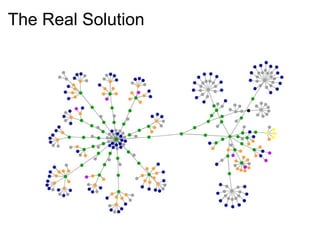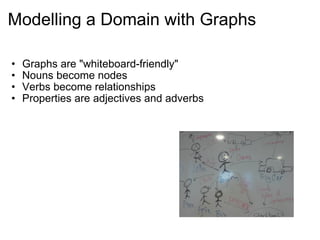Graph Databases
- 1. Graph Databases Josh Adell <[email protected]> 20110719
- 2. Who am I? Software developer: PHP, Javascript, SQL http://www.dunnwell.com Fan of using the right tool for the job
- 3. The Problem
- 4. The Solution? > -- Given "Keanu Reeves" find a connection to "Kevin Bacon" > SELECT ??? FROM cast WHERE ??? +---------------------------------------------------------------------+ | actor_name | movie_title | +============================+========================================+ | Jennifer Connelley | Higher Learning | +----------------------------+----------------------------------------+ | Laurence Fishburne | Mystic River | +----------------------------+----------------------------------------+ | Laurence Fishburne | Higher Learning | +----------------------------+----------------------------------------+ | Kevin Bacon | Mystic River | +----------------------------+----------------------------------------+ | Keanu Reeves | The Matrix | +----------------------------+----------------------------------------+ | Laurence Fishburne | The Matrix | +----------------------------+----------------------------------------+
- 5. Find Every Actor at Each Degree > -- First degree > SELECT actor_name FROM cast WHERE movie_title IN (SELECT DISTINCT movie_title FROM cast WHERE actor_name='Kevin Bacon') > -- Second degree > SELECT actor_name FROM cast WHERE movie_title IN (SELECT DISTINCT movie_title FROM cast WHERE actor_name IN (SELECT actor_name FROM cast WHERE movie_title IN (SELECT DISTINCT movie_title FROM cast WHERE actor_name='Kevin Bacon'))) > -- Third degree > SELECT actor_name FROM cast WHERE movie_title IN(SELECT DISTINCT movie_title FROM cast WHERE actor_name IN (SELECT actor_name FROM cast WHERE movie_title IN (SELECT DISTINCT movie_title FROM cast WHERE actor_name IN (SELECT actor_name FROM cast WHERE movie_title IN (SELECT DISTINCT movie_title FROM cast WHERE actor_name='Kevin Bacon'))))
- 6. The Truth Relational databases aren't very good with relationsh ips Data RDBMs
- 7. RDBs Use Set Math
- 8. The Real Problem Finding relationships across multiple degrees of separation ...and across multiple data types ...and where you don't even know there is a relationship
- 10. Computer Science Definition A graph is an ordered pair G = (V, E) where V is a set of vertices and E is a set of edges , which are pairs of vertices.
- 11. Some Graph DB Vocabulary Node : vertex Relationship : edge Property : meta-datum attached to a node or relationship Path : an ordered list of nodes and relationships Index : node or relationship lookup table
- 12. Relationships are First-Class Citizens Have a type Have properties Have a direction Domain semantics Traversable in any direction
- 13. Graph Examples
- 14. Relational Databases are Graphs!
- 15. New Solution to the Bacon Problem $keanu = $actorIndex->find('name', 'Keanu Reeves'); $kevin = $actorIndex->find('name', 'Kevin Bacon'); $path = $keanu->findPathTo($kevin);
- 16. Some Graph Use Cases Social networking Manufacturing Map directions Fraud detection Multi-tenancy
- 17. Modelling a Domain with Graphs Graphs are "whiteboard-friendly" Nouns become nodes Verbs become relationships Properties are adjectives and adverbs
- 19. Neo Technologies http://neo4j.org Embedded in Java applications Standalone server via REST Plugins: spatial, lucene, rdf http://github.com/jadell/Neo4jPHP
- 20. Using the REST client $client = new Client(new Transport()); $customer = new Node($client); $customer->setProperty('name', 'Josh')->save(); $store = new Node($client); $store->setProperty('name', 'Home Despot') ->setProperty('location', 'Durham, NC')->save(); $order = new Node($client); $order->save(); $item = new Node($client); $item->setProperty('item_number', 'Q32-ESM')->save(); $order->relateTo($item, 'CONTAINS')->save(); $customer->relateTo($order, 'BOUGHT')->save(); $store->relateTo($order, 'SOLD')->save(); $customerIndex = new Index($client, Index::TypeNode, 'customers'); $customerIndex->add($customer, 'name', $customer->getProperty('name')); $customerIndex->add($customer, 'rating', 'A++');
- 21. Graph Mining Paths Traversals Ad-hoc Queries
- 22. Path Finding Find any connection from node A to node B Limit by relationship types and/or direction Path finding algorithms: all, simple, shortest, Dijkstra $customer = $customerIndex->findOne('name', 'Josh'); $item = $itemIndex->findOne('item_number', 'Q32-ESM'); $path = $item->findPathsTo($customer) ->setMaxDepth(2) ->getSinglePath(); foreach ($path as $node) { echo $node->getId() . "\n"; }
- 23. Traversal Complex/Custom path finding Base next decision on previous path $traversal = new Traversal($client); $traversal ->setOrder(Traversal::OrderDepthFirst) ->setUniqueness(Traversal::UniquenessNodeGlobal) ->setPruneEvaluator('javascript','(function traverse(pos) { if (pos.length() == 1 && pos.lastRelationship.getType() == "CONTAINS") { return false; } else if (pos.length() == 2 && pos.lastRelationship.getType() == "BOUGHT") { return false; } return true;})(position)') ->setReturnFilter('javascript', 'return position.endNode().getProperty('type') == 'Customer;'); $customers = $traversal->getResults($item, Traversal::ReturnTypeNode);
- 24. Uses mathematical notation approach Complex traversal behaviors, including backtracking https://github.com/tinkerpop/gremlin/wiki m = [:] g.v(1).out('likes').in('likes').out('likes').groupCount(m) m.sort{a,b -> a.value <=> b.value}
- 25. Cypher "What to find" vs. "How to find" $query = 'START item=(1) MATCH (item)<-[:CONTAINS]-(order)<-[:BOUGHT]-(customer) RETURN customer'; $cypher = new Cypher\Query($client, $query); $customers = $cypher->getResultSet();
- 26. Cypher Syntax START item = (1) START item = (1,2,3) START item = (items, 'name:Q32*') START item = (1), customer = (2,3) MATCH (item)<--(order) MATCH (order)-->(item) MATCH (order)-[r]->(item) MATCH ()--(item) MATCH (supplier)-[:SUPPLIES]->(item)<-[:CONTAINS]-(order), (customer)-[:RATED]->(item) WHERE customer.name = 'Josh' and s.coupon = 'freewidget' RETURN item, order RETURN customer, item, r.rating RETURN r~TYPE RETURN COUNT(*) ORDER BY customer.name DESC RETURN AVG(r.rating) LIMIT 3 SKIP 2
- 27. Cypher - All Together Now // Find the top 10 `widget` ratings by customers who bought AND rated // `widgets`, and the supplier START item = (items, 'name:widget') MATCH (item)<--(order)<--(customer)-[r:RATED]->(item)<--(supplier) RETURN customer, r.rating, supplier ORDER BY r.rating DESC LIMIT 10
- 29. Are RDBs Useful At All? Aggregation Ordered data Truly tabular data Few or clearly defined relationships
- 30. Questions?
- 31. Resources http://neo4j.org http://docs.neo4j.org http://www.youtube.com/watch?v=UodTzseLh04 Emil Eifrem (Neo Tech. CEO) webinar Check out around the 54 minute mark http://github.com/jadell/Neo4jPHP http://joshadell.com [email_address] @josh_adell Google+, Facebook, LinkedIn
Editor's Notes
- #3: * graph db usage poll
- #4: * Six degrees game * Relational databases can't easily answer certain types of questions
- #5: * first pass using a relational database * cast table: actor_name, movie_title * hard to visualize the solution * In order to do this, you need to do multiple passes or joins
- #6: * Each degree adds a join * Increases complexity * Decreases performance * Stop when the actor you're looking for is in the list
- #7: * this problem highlights the ugly truth about RDBs * they weren't designed to handle these types of problems. * RDB relationships join data, but are not data in themselves
- #8: * Gather everything in the set that matches these criteria, then tell me if this thing is in the set * 1 set, no problem * 2nd set no problem * 3rd set not related to 1st * 4th not related to 2nd * 5th related to 1st and 4th * etc. * Relationships are only available between overlapping sets
- #9: * disjoint sets
- #10: * Graphs * Not X-Y * Computer Science definition of graphs
- #11: * graph theory
- #12: * Nodes can have arbitrary properties * Relationships can have arbitrary properties * Paths are found using traversal algorithms * Indexes help find starting points
- #13: * This is how graph dbs solve the problems that RDBs can't
- #14: * Tree data-structures * Networks * Maps * vehicles on streets == packets through network
- #15: * Make each record a node * Make every foreign key a relationship * RDB indexes are usually stored in a tree structure * Trees are graphs * Why not use RDBs? * The trouble with RDBs is how they are stored in memory and queried * Require a translation step from memory blocks to graph structure * Relationships not first-class citizens * Many problem domains map poorly to rows/tables
- #16: * Actors are nodes * Movies are nodes * Relationship: Actor is IN a movie * pseudo-code shortened for brevity * Compare to degree selection join queries
- #17: * Social networking - friends of friends of friends of friends * Assembly/Manufacturing - 1 widget contains 3 gadgets each contain 2 gizmos * Map directions - starting at my house find a route to the office that goes past the pub * Multi-tenancy - root node per tenant * all queries start at root * No overlap between graphs = no accidental data spillage * Fraud: track transactions back to origination * Pretty much anything that can be drawn on a whiteboard
- #18: * Example: retail system * Customer makes Order * Store sells Order * Order contains Items * Supplier supplied Items * Customer rates Items * Did this customer rank supplier X highly? * Which suppliers sell the highest rated items? * Does item A get rated higher when ordered with Item B? * All can be answered with RDBs as well * Not as elegant * Not as performant
- #19: * Recreate Google+
- #20: * billions of nodes and relationships in a single instance * cluster replication * transactions * native bindings for Ruby, Python, and language that can run in JVM * Licensing * Neo4jPHP - Josh's REST client, no affiliated with Neo Technologies
- #21: * Index can be saved separately * Or it is saved on `add` * Note that indexes don't have to be on real properties or values
- #22: * This is where the power of graph dbs comes from * Paths - find any relationship chain between A and B * Traversal - filter out paths that don't meet criteria * Queries - Here is what I want, find it however you can
- #23: * Paths deal with two known nodes * start and end point * This is the Kevin Bacon example, but with multiple datatypes * Path can be treated as an array of nodes or relationships * findPathsTo() returns a PathFinder which can have further restrictions placed on it
- #24: * Written in Javascript * plugins provide other languages: Groovy, Python * Anything that runs on JVM * Path object, check apidocs * inline edit/update/delete * explicit prune evaluator of maxDepth = 1 unless overriden * built in prune: none * built in return: all or all-but-start * Prune: should we continue doen this path? Return: Should we return the entity at this position? * You can return things and still continue traversing * Pros: expressive, powerful, complex search behaviors, in-line edit/update * Cons: complex to write, complex to understand (query languages make this better)
- #25: * Not very familiar with it * Just mentioning it's out there
- #26: * Cypher is &quot;what to find&quot; * describe the &quot;shape&quot; of the thing you're looking for * Very white-board friendly * Pros: easy to understand, query looks like domain model * Cons: not as powerful, not fully featured (YET) * result set is an array of arrays
- #27: * Three parts ** Where to start ** Shape to find ** possibly qualifiers ** What to return
- #28: * If there could be more than one relationship type, could further constrain by ratings
- #29: * Webadmin built into neo4j server
- #30: * RDBs are really good at data aggregation * Set math, duh * Have to traverse the whole graph in order to do aggregation * Truly tabular means not a lot of relationships between the data types
























![Uses mathematical notation approach Complex traversal behaviors, including backtracking https://github.com/tinkerpop/gremlin/wiki m = [:] g.v(1).out('likes').in('likes').out('likes').groupCount(m) m.sort{a,b -> a.value <=> b.value}](https://image.slidesharecdn.com/8640008/85/Graph-Databases-24-320.jpg)
![Cypher "What to find" vs. "How to find" $query = 'START item=(1) MATCH (item)<-[:CONTAINS]-(order)<-[:BOUGHT]-(customer) RETURN customer'; $cypher = new Cypher\Query($client, $query); $customers = $cypher->getResultSet();](https://image.slidesharecdn.com/8640008/85/Graph-Databases-25-320.jpg)
![Cypher Syntax START item = (1) START item = (1,2,3) START item = (items, 'name:Q32*') START item = (1), customer = (2,3) MATCH (item)<--(order) MATCH (order)-->(item) MATCH (order)-[r]->(item) MATCH ()--(item) MATCH (supplier)-[:SUPPLIES]->(item)<-[:CONTAINS]-(order), (customer)-[:RATED]->(item) WHERE customer.name = 'Josh' and s.coupon = 'freewidget' RETURN item, order RETURN customer, item, r.rating RETURN r~TYPE RETURN COUNT(*) ORDER BY customer.name DESC RETURN AVG(r.rating) LIMIT 3 SKIP 2](https://image.slidesharecdn.com/8640008/85/Graph-Databases-26-320.jpg)
![Cypher - All Together Now // Find the top 10 `widget` ratings by customers who bought AND rated // `widgets`, and the supplier START item = (items, 'name:widget') MATCH (item)<--(order)<--(customer)-[r:RATED]->(item)<--(supplier) RETURN customer, r.rating, supplier ORDER BY r.rating DESC LIMIT 10](https://image.slidesharecdn.com/8640008/85/Graph-Databases-27-320.jpg)



![Resources http://neo4j.org http://docs.neo4j.org http://www.youtube.com/watch?v=UodTzseLh04 Emil Eifrem (Neo Tech. CEO) webinar Check out around the 54 minute mark http://github.com/jadell/Neo4jPHP http://joshadell.com [email_address] @josh_adell Google+, Facebook, LinkedIn](https://image.slidesharecdn.com/8640008/85/Graph-Databases-31-320.jpg)